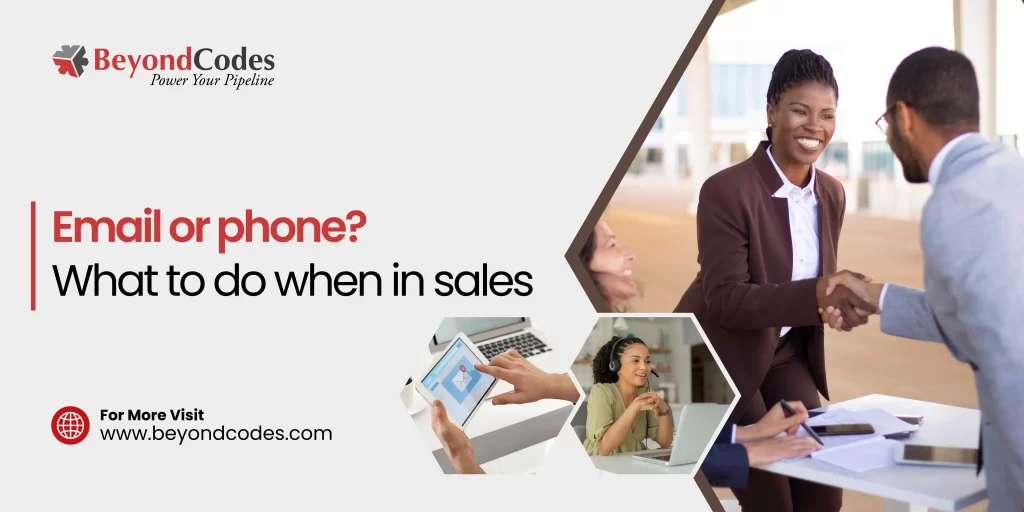The method of outreach sales reps use for a first connect makes a significant difference in response rates. Rather than deciding whether to call a new prospect or send an email based on personal preference, use the method your prospect will be most responsive to.
Which leads me to the question: Phone or email? While there are a few tips that can help you decide, sales reps should know that in the grand scheme of a sales engagement, it’s phone and email. However, I’m specifically addressing the first touch in this article, and since you shouldn’t issue an identical email and voicemail, you have to make a choice.
When deciding between trying a prospect by phone or sending an email, let the following four factors be your guide.
TIME AND DAY OF THE WEEK
First, consult a calendar and a clock. Statistically, phone connect rates rise as the day progresses, and as the week progresses. In other words, a person is more likely to answer their phone later in the workday and the workweek.
That said, we like to reserve 3 p.m. and later of the prospect’s local time as our prime calling hours. Same goes for Thursdays and Fridays — We block out large chunks of time on these days for cold calling.
But what if a prospect doesn’t pick up their phone in these timeframes? Leave a voicemail. Response rates to voicemails also increase later in the day since checking phone messages is something people often do before heading home for the evening. Calling late is a win-win.
On the other hand, the ideal timespan in which to send email is shorter but more frequent. While we draft connect emails throughout the day, we must be careful to send them either 10 minutes before the hour or 10 minutes after the hour. These brief windows correspond with people leaving or going to meetings. What do they do with the few minutes they have to kill? Scroll through email on their smartphones. If we sync the email to be sent to the time our buyer is most likely to check their inbox, our message will pop up on top instead of being buried beneath others.
THE ASK
What’s your objective for this first outreach?
To set up a meeting? Get some more information? Receive a referral? Figuring out our ask and categorizing it as “weak” or “strong” would help us determine whether to call or email.
Strong asks require commitment from the prospect to do something. We must label requests for meetings, conference calls, or product trials as strong closes. Weak asks seek straightforward information from the buyer — think a prompt for feedback or a referral.
Once we know our close and have determined if it’s strong or weak, it’s easy to choose between a call or an email. If we’re putting forth a strong close, pick up the phone. Because these asks require more from the prospect, salespeople need to employ their closing skills to secure a “yes.” And it’s far easier to persuade on a phone call when a rep can respond to and smooth over objections in real time.
But if the ask is weak, draft an email. Don’t take up the prospect’s time on the phone unnecessarily if your request can be fulfilled with a few short lines of text.
It’s interesting to note that most salespeople take the opposite approach — they ask buyers for meetings through emails and reserve simple questions for calls. Why? Because they’re afraid of being rejected on a strong ask over the phone.
Don’t let fear block your way to connecting with a buyer. Reverse this equation and watch your response rates climb.
THE LEVEL OF THE PROSPECT
Do individual contributors have assistants? Not usually. But do C-level executives? Almost always.
That’s why the higher up your prospect is in an organization, the more likely you are to reach a live person when you call. Since a live conversation with anyone — regardless of whether they’re the person you were trying to reach or not — trumps an email exchange, lean on the phone with buyers at the management level or above. Also, higher-level prospects are generally more comfortable on the phone, and less intimidated by sales calls.
But if individual contributors don’t answer their phones, no one else is going to pick up — and they’re not likely to return a call from an unknown number. In addition, lower-level professionals are often away from their desks — traveling, working in groups, participating in meetings, and so on. Therefore, a rep is much more likely to connect with a prospect at this level through an asynchronous channel such as email.According to a survey, the possibility of conversion increases exponentially with the increase in the level of the prospect of the respective firm.
THE BUYER PERSONA
Some buyer personas favor a different communication style than others. Their preference depends on multiple factors: Their age, the nature of their job, their industry, and more.
In general, millennials like communicating by email more than over the phone. If we’re reaching out to a younger buyer, always take this into account.
We might find professionals in customer-facing roles are more amenable to talking on the phone — because that’s what they’re used to. Those in internal jobs, however, may be more comfortable sending emails.
Lastly, those in more traditional industries are typically accustomed to phone calls.
FOLLOWING UP
These four criteria make it much easier to choose between an email and a phone call for your first outreach. But what about subsequent touch points?
In most real-time cases, the beginning and the end of each sales engagement should be phone-heavy, since that’s where the strongest asks are — starting a relationship and closing a deal. In between, reps should opt for email as a rule of thumb.







